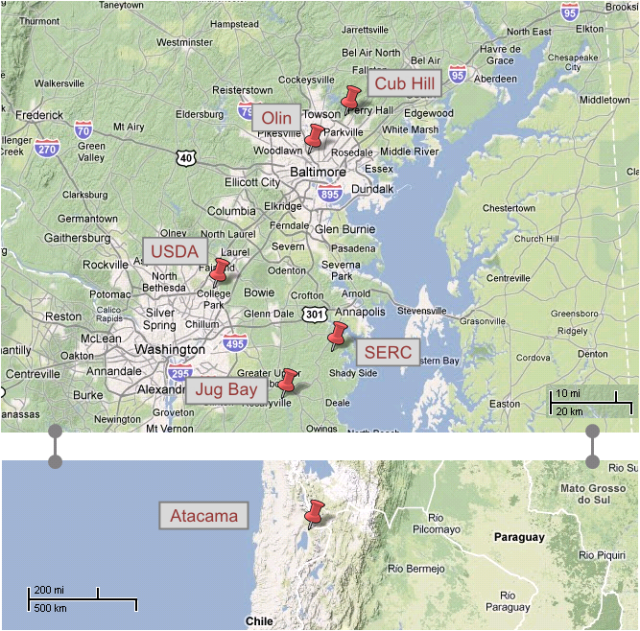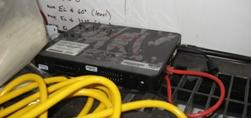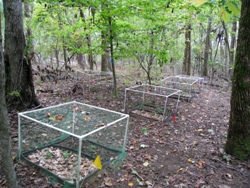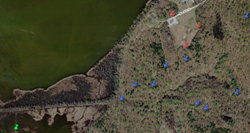Sensor deployment history and details

|
| A high-level map of all our deployments. |
Atacama
|
This deployment is located in the Atacama desert in Chile.
Atacama is one of the highest, driest places on Earth. These
sensors are co-located with the
Atacama Cosmological Telescope.
The goal of this deployment is to understand how the hardware survives in an
extreme environment. In addition to the cold, dry climate, the desert is exposed to high UV radiation.
These boxes are collecting soil temperature, soil moisture
and soil CO2 data.
|
 |
Deployment Details:
| Location |
Start |
End |
Sampling Locations |
|
| Atacama, Chile |
August 18, 2009 |
ongoing |
3 |
|
 |
|
This deployment is located in the fields of the
farming system project at BARC .
Soil temperature and moisture probes are placed at various locations of a
corn-soybean-wheat rotation. The goal is to understand and explain soil heterogeneity and to provide background data
for trace gase measurements.
|
 |
|
|
Deployment Details:
| Location |
Start |
End |
Sampling Locations |
|
| Beltsville, MD |
July 23, 2009 |
ongoing |
22 |
|
 |
|
This deployment is located at the
Smithsonian Environmental Research Center (SERC) in Edgewater, MD.
Data from this deployment is aimed at understanding the effect
of forest age, leaf litter input, and earthworm abundance on soil carbon cycling.
Two patches are deployed as part of this study. One of them is a mature forest and the
other is a younger successional forest.
These two patches are around 300m apart. They are connected using a set of relay nodes.
A basestation is located at the foot of a tower located roughly half a kilometer from the
SERC facilities. A long range radio link sends the data from the top of the tower to the
SERC facility.
Our sensor network
technology provides high resolution soil temperature and moisture data to understand
leaf litter decomposition, soil animal activity and soil respiration. The site also hosts 2
CO2 sensing locations that collect soil CO2 at 3 different
depths every 10 minutes.
|
 |
|
|
Deployment Details:
| Location |
Start |
End |
Sampling Locations |
|
| Edgewater, MD |
March 11, 2009 |
ongoing |
37 |
|
 |
Cub Hill
|
The Cub Hill deployment is located in an suburban residential
area northeast of Baltimore. The site hosts a CO2 flux tower that collects
ambient CO2 and meterological data. The goal of this study is to
understand the effects of land use and land cover on soil conditions and to correlate measurements of soil conditions
with the data obtained from the CO2 flux tower.
The sensor network collects soil CO2,
soil temperature, soil moisture, ambient temperature, and light.
This is our largest deployment at the moment.
|
 |
|
|
Deployment Details:
| Location |
Start |
End |
Sampling Locations |
|
| Parkville, MD |
July 29, 2008 |
ongoing |
53 |
|
 |
Olin-II (Johns Hopkins University)
|
This deployment is located in a forested area adjacent to Olin Hall on the Homewood campus of the Johns Hopkins University.
Eighteen sensors in a grid formation monitor soil temperature and moisture, helping us answer
questions about the activities of soil organisms.
This deployment also serves as a development testbed where improvements are tested before they are
propogated to our other remote sites.
|
 |
|
|
Deployment Details:
| Location |
Start |
End |
Sampling Locations |
|
| JHU (Homewood campus) |
July 13, 2008 |
ongoing |
18 |
|
 |
|
We monitored the soil temperature and
soil moisture in the habitat which Eastern Box Turtles lay their eggs.
These nests were located in the Jug Bay Wetlands Sanctuary
in Anne Arundel County, MD.
The objective of the study was to monitor soil conditions during turtle egg incubation
in different micro-habitats.
The nesting conditions were studied at 11 different locations:
three in 2007 and eight in 2008.
During the winter of 2007-08, we also monitored
the soil conditions under which turtles overwinter. We identified 10 overwintering locations
and collected temperature and moisture data at those locations. This deployment was the first time we used
our second generation hardware and software changes.
|
 |
|
|
Deployment Details:
| Location |
Start |
End |
Sampling Locations |
|
| Anne Arundel Co., MD |
June 22, 2007 |
April 26, 2008 |
13 (I), 8(II) |
|
 |
Leakin Park
|
For our second deployment, we had several goals. First, we wanted to compare our
sensor technology to the data collection protocol and equipment
of the Baltimore Ecosystem Study (BES)
. To achieve this, we deployed six sensors in Leakin Park, a permanent forest plot of BES. Second, we monitored
background conditions for leaf litter decomposition experiments. Last, we wanted to study how much
soil moisture and soil temperature vary over on a medium scale.
This deployment provided us with some valuable lessons regarding the accuracy of the timestamps
assigned to the collected data. We also learned some valuable lessons regarding the importance
of collecting metadata for provenance purposes.
|
 |
|
|
Deployment Details:
| Location |
Start |
End |
Sampling Locations |
|
| Leakin Park, Baltimore MD |
March 3, 2006 |
November 5, 2007 |
6 |
|
|
Olin-I (Johns Hopkins University)
|
This was our first deployment, designed to test our first generation motes.
We collected data once per minute, for a total of 125 MB. The test data we collected here
led to a new generation of soil moisture sensors, soil temperature sensors, hardware, software
and storage designs. These lessons were applied to later deployments.
|
 |
|
|
Deployment Details:
| Location |
Start |
End |
Sampling Locations |
|
| Olin Hall JHU, Baltimore MD |
September 9, 2005 |
July 21, 2006 |
10 |
|
|
|
